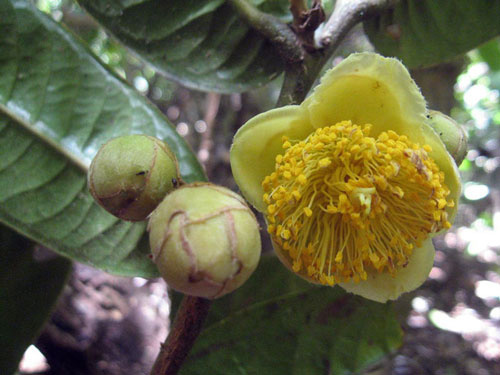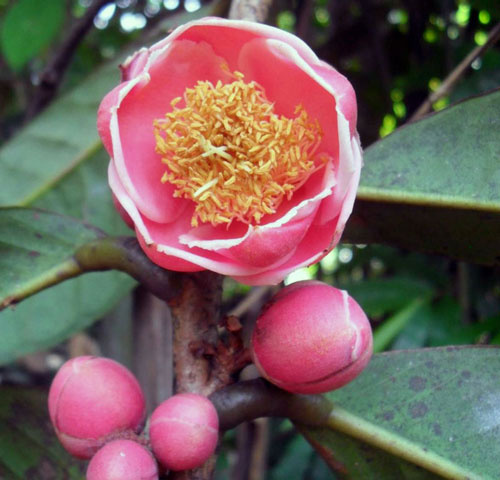Detecting rare and precious lilies
The authors Luong Van Dung (Da Lat University), Tran Ninh (University of Natural Sciences, National University of Hanoi) and Hakoda (Japan) have just announced a new species of rare eyelash tea in domestic and international magazines. .
Of the 3,000 hybrids in the world, Lam Dong is one of the most 'settled' lilies, accounting for about 4.3% but more specifically, 13 species belonging to genus distributed of course in Lam Dong. Information was delivered by Mr. Luong Van Dung on January 16 afternoon.

'' Da Lat '' tea has just been announced as a new endemic species
Lam Dong currently has about 125 - 130 mi tea varieties originating from foreign countries such as France, America, Australia, Netherlands, Taiwan, Japan, China, Czechoslovakia . Many establishments collect these varieties as Mr. De's tea gardens (Da Sar commune), Mr. Hung (Da Nghi commune) and Mr. Tho (Hung Vuong street in Da Lat city) and Da Lat flower garden have about 200 trees. Mainly hybrid breeds from parent sources, colors are often red, white, pink, purple, yellow, light green.
Rich and endemic
After many years of studying and researching all 4 altitude areas, the research group Dr. Nguyen Van Ket - MSc Luong Van Dung (Da Lat University) has published many interesting information about the limbs natural father in Lam Dong. Up to this point, 13 species have been identified.
Among them, 11 species have been identified by Vietnamese and foreign scientists. Yellow lobe tea (Camellia luteocerata Orel) distributes Cat Tien National Park and along Dong Nai river; tea with flat branches (Camellia inusitata Orel, Curry & Luu) distributed in Biduop - Nui Ba just announced in 2012. These are 2 species with Da Lat tea (Camellia dalatensis Luong, Tran & Hakoda) and Vidal mi tea ( Camellia vidalii Rosmann) is endemic.

Red eyelash tea in Da Huoai, Da Teh and Cat Tien areas
There are 2 other new species not identified: Di Linh tea (Camellia sp2.) Yellow orange and Dam mi (Camellia sp1.) Yellow yellow flowers with the same height distribution of 600-1,000 m. More amazing is the fruit of Di Linh tea (Camellia sp2.) Unlike any other tea in the world published in the current document, MSc Luong Van Dung affirmed.

The 'Di Linh' tea is not yet identified but has a very different shape
The information is more 'hot' when the authors Luong Van Dung (Da Lat University), Tran Ninh (University of Natural Sciences, Hanoi National University) and Hakoda (Japan) have announced the discovery of species. New and rare tea brands in scientific journals in Vietnam and abroad (International Camellia Journal - International tea).

Tea with special pink chalk, Di Linh and Bao Lam distribution areas
This tea is named Camellia dalatensis Luong, Tran & Hakoda. It is distributed at elevations above 1,500m, under the evergreen broadleaf and broadleaf-coniferous forest canopy in Da Lat and adjacent. This is a small tree species, about 3-4m high; young branches with thick hair; old twigs. Leaves have long stalks of 0.7-1.2cm, with feathers, 40-45cm long, 8-11cm wide . Flowers 1-3 in leaf axils, pale yellow, 4.0-4.5cm in diameter; flower stalks 2.0-2.5 cm long; 5 sepals, 8-10 wings; many binary sets, 1.4-1.7cm long. This light yellow tea has a spherical fruit, 4.5-5.5cm in diameter, 4-5 plots, 1 to 2 seeds each.
Endangered
Not to mention the medicinal properties, mi tea is currently one of the most beautiful ornamental plants in the office and home because fruits are beautiful, luxurious and high. The price of each plant has flower pots ranging from 400-800,000 VND / tree depending on the type. So the tree hunters scoured the forests but couldn't find much because the tea distribution was not concentrated.

White eyelash tea in Da Lat area
The results of the Lam Dong tea research group were evaluated by Mr. Nguyen Duy Chinh as "very successful" . MSc Luong Van Dung, PhD student, is the author of the research project: Lam Dong natural tea species are distributed in poor forest areas or mixed wood-bamboo forests, so when converting into a production forest, of course, the tea lilies will be in danger of being eradicated, especially yellow-flowered tea.
In order to seek help, Dr. Nong Van Tiep suggested that the narrow distribution zone should be confirmed soon, but it could be useful to preserve the tea species in Lam Dong. Whenever the ecological environment of the tea is affected, it will be very difficult to survive. Especially in the situation of people as well as managers are indifferent and ignorant of the scientific nature of tea species.'The tea will disappear sooner or later,' - TS Next warned.
Chairman of the scientific project 'Investigating tea in Lam Dong' - Dr. Nguyen Van Ket, Dean of the Faculty of Agriculture and Forestry at Dalat University, is very anxious to comment: Deforested forest, risk of tea species It is clear and has been lost. Therefore, in the coming time, the group will study the approach towards pharmacological analysis and especially analyze the disadvantages for the development of tea species in Lam Dong as the competitiveness of space and nutrition . But First of all, there must be a close connection between scientists, managers and people, and hope that Lam Dong may and the rare and precious tea species will escape the threat of invasion and extermination.
- Me looking at the white lilies in April
- Detecting bile trees with diameter
- The 115 million-year fossil of the world's oldest lilies
- Detecting precious material mines used as solar cells under the seabed
- Protection of a rare and precious herd of flocks in Muong Phang commune
- Saigon people caught rare and precious ancient birds weighing 1kg
- Discover a rare and precious conifer population in Lao Cai
- German police shot rare cows 250 years a time
- Hanoi and the season of beautiful flowers captivated people
- Strange fungus 'cover face' like beauty, the most rare and precious in Vietnam
- New discovery of precious and rare amphibian species
- Finding rare and precious mushrooms
 Why do potatoes have eyes?
Why do potatoes have eyes? 'Tragedy' the world's largest carnivorous life: Death becomes ... public toilet
'Tragedy' the world's largest carnivorous life: Death becomes ... public toilet Tomatoes were once considered 'poisonous' for 200 years
Tomatoes were once considered 'poisonous' for 200 years Detecting microscopic parasites on human face
Detecting microscopic parasites on human face